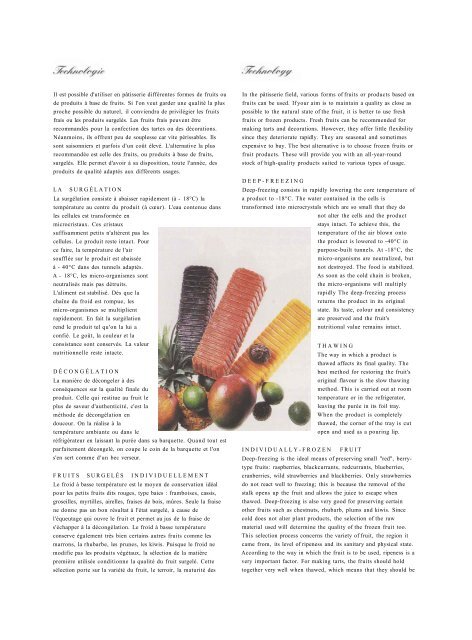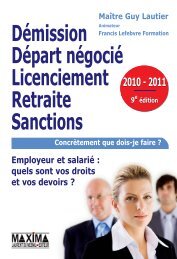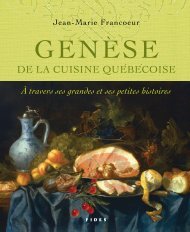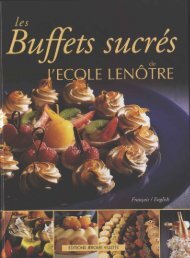Ecole Lenotre
Ecole Lenotre
Ecole Lenotre
You also want an ePaper? Increase the reach of your titles
YUMPU automatically turns print PDFs into web optimized ePapers that Google loves.
Il est possible d'utiliser en pâtisserie différentes formes de fruits ou<br />
de produits à base de fruits. Si l'on veut garder une qualité la plus<br />
proche possible du naturel, il conviendra de privilégier les fruits<br />
frais ou les produits surgelés. Les fruits frais peuvent être<br />
recommandés pour la confection des tartes ou des décorations.<br />
Néanmoins, ils offrent peu de souplesse car vite périssables. Ils<br />
sont saisonniers et parfois d'un coût élevé. L'alternative la plus<br />
recommandée est celle des fruits, ou produits à base de fruits,<br />
surgelés. Elle permet d'avoir à sa disposition, toute l'année, des<br />
produits de qualité adaptés aux différents usages.<br />
LA SURGÉLATION<br />
La surgélation consiste à abaisser rapidement (à - 18°C) la<br />
température au centre du produit (à cœur). L'eau contenue dans<br />
les cellules est transformée en<br />
microcristaux. Ces cristaux<br />
suffisamment petits n'altèrent pas les<br />
cellules. Le produit reste intact. Pour<br />
ce faire, la température de l'air<br />
soufflée sur le produit est abaissée<br />
à - 40°C dans des tunnels adaptés.<br />
A - 18°C, les micro-organismes sont<br />
neutralisés mais pas détruits.<br />
L'aliment est stabilisé. Dès que la<br />
chaîne du froid est rompue, les<br />
micro-organismes se multiplient<br />
rapidement. En fait la surgélation<br />
rend le produit tel qu'on la lui a<br />
confié. Le goût, la couleur et la<br />
consistance sont conservés. La valeur<br />
nutritionnelle reste intacte.<br />
DÉCONGÉLATION<br />
La manière de décongeler à des<br />
conséquences sur la qualité finale du<br />
produit. Celle qui restitue au fruit le<br />
plus de saveur d'authenticité, c'est la<br />
méthode de décongélation en<br />
douceur. On la réalise à la<br />
température ambiante ou dans le<br />
réfrigérateur en laissant la purée dans sa barquette. Quand tout est<br />
parfaitement décongelé, on coupe le coin de la barquette et l'on<br />
s'en sert comme d'un bec verseur.<br />
FRUITS SURGELÉS INDIVIDUELLEMENT<br />
Le froid à basse température est le moyen de conservation idéal<br />
pour les petits fruits dits rouges, type baies : framboises, cassis,<br />
groseilles, myrtilles, airelles, fraises de bois, mûres. Seule la fraise<br />
ne donne pas un bon résultat à l'état surgelé, à cause de<br />
l'équeutage qui ouvre le fruit et permet au jus de la fraise de<br />
s'échapper à la décongélation. Le froid à basse température<br />
conserve également très bien certains autres fruits comme les<br />
marrons, la rhubarbe, les prunes, les kiwis. Puisque le froid ne<br />
modifie pas les produits végétaux, la sélection de la matière<br />
première utilisée conditionne la qualité du fruit surgelé. Cette<br />
sélection porte sur la variété du fruit, le terroir, la maturité des<br />
In the pâtisserie field, various forms of fruits or products based on<br />
fruits can be used. If your aim is to maintain a quality as close as<br />
possible to the natural state of the fruit, it is better to use fresh<br />
fruits or frozen products. Fresh fruits can be recommended for<br />
making tarts and decorations. However, they offer little flexibility<br />
since they deteriorate rapidly. They are seasonal and sometimes<br />
expensive to buy. The best alternative is to choose frozen fruits or<br />
fruit products. These will provide you with an all-year-round<br />
stock of high-quality products suited to various types of usage.<br />
DEEP-FREEZING<br />
Deep-freezing consists in rapidly lowering the core temperature of<br />
a product to -18°C. The water contained in the cells is<br />
transformed into microcrystals which are so small that they do<br />
not alter the cells and the product<br />
stays intact. To achieve this, the<br />
temperature of the air blown onto<br />
the product is lowered to -40°C in<br />
purpose-built tunnels. At -18°C, the<br />
micro-organisms are neutralized, but<br />
not destroyed. The food is stabilized.<br />
As soon as the cold chain is broken,<br />
the micro-organisms will multiply<br />
rapidly The deep-freezing process<br />
returns the product in its original<br />
state. Its taste, colour and consistency<br />
are preserved and the fruit's<br />
nutritional value remains intact.<br />
THAWING<br />
The way in which a product is<br />
thawed affects its final quality. The<br />
best method for restoring the fruit's<br />
original flavour is the slow thawing<br />
method. This is carried out at room<br />
temperature or in the refrigerator,<br />
leaving the purée in its foil tray.<br />
When the product is completely<br />
thawed, the corner of the tray is cut<br />
open and used as a pouring lip.<br />
INDIVIDUALLY-FROZEN FRUIT<br />
Deep-freezing is the ideal means of preserving small "red", berry-<br />
type fruits: raspberries, blackcurrants, redcurrants, blueberries,<br />
cranberries, wild strawberries and blackberries. Only strawberries<br />
do not react well to freezing; this is because the removal of the<br />
stalk opens up the fruit and allows the juice to escape when<br />
thawed. Deep-freezing is also very good for preserving certain<br />
other fruits such as chestnuts, rhubarb, plums and kiwis. Since<br />
cold does not alter plant products, the selection of the raw<br />
material used will determine the quality of the frozen fruit too.<br />
This selection process concerns the variety of fruit, the region it<br />
came from, its level of ripeness and its sanitary and physical state.<br />
According to the way in which the fruit is to be used, ripeness is a<br />
very important factor. For making tarts, the fruits should hold<br />
together very well when thawed, which means that they should be








